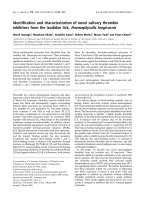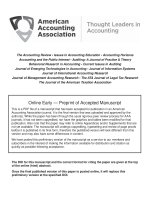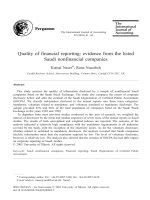Baubeau ogren (eds ) convergence and divergence of national financial systems; evidence from the old gold standard, 1871 1971 (2010)
Bạn đang xem bản rút gọn của tài liệu. Xem và tải ngay bản đầy đủ của tài liệu tại đây (3.29 MB, 321 trang )
CONVERGENCE AND DIVERGENCE OF
NATIONAL FINANCIAL SYSTEMS:
EVIDENCE FROM THE GOLD STANDARDS,
1871–1971
FINANCIAL HISTORY
Series Editor: Robert E. Wright
Titles in this Series
1 Slave Agriculture and Financial Markets in Antebellum America: The Bank
of the United States in Mississippi, 1831–1852
Richard Holcombe Kilbourne, Jr
2 The Political Economy of Sentiment: Paper Credit and the Scottish Enlightenment in Early Republic Boston, 1780–1820
Jose R. Torre
3 Baring Brothers and the Birth of Modern Finance
Peter E. Austin
4 Gambling on the American Dream: Atlantic City and the Casino Era
James R. Karmel
5 Government Debts and Financial Markets in Europe
Fausto Piola Caselli (ed.)
6 Virginia and the Panic of 1819: The First Great Depression and the
Commonwealth
Clyde A. Haulman
7 Towards Modern Public Finance: The American War with Mexico,
1846–1848
James W. Cummings
8 The Revenue Imperative: The Union’s Financial Policies during the
American Civil War
Jane Flaherty
9 Guilty Money: The City of London in Victorian and Edwardian Culture,
1815–1914
Ranald C. Michie
10 Financial Markets and the Banking Sector: Roles and Responsibilities in a
Global World
Elisabeth Paulet (ed.)
11 Argentina’s Parallel Currency: The Economy of the Poor
Georgina M. Gómez
12 The Rise and Fall of the American System: Nationalism and the Development of the American Economy, 1790–1837
Songho Ha
Forthcoming Titles
Benjamin Franklin and the Invention of Microfinance
Bruce Yenawine, ed. Michele Costello
Federal Banking in Brazil: Policies and Competitive Advantages
Kurt E. von Mettenheim
The Development of International Insurance
Robin Pearson (ed.)
The Development of the Art Market in England: Money as Muse, 1730–1900
Thomas M. Bayer and John R. Page
Camille Gutt and Postwar International Finance
Jean F. Crombois
www.pickeringchatto.com/financialhistory
CONVERGENCE AND DIVERGENCE OF
NATIONAL FINANCIAL SYSTEMS:
EVIDENCE FROM THE GOLD STANDARDS,
1871–1971
Edited by
Patrice Baubeau and Anders Ögren
london
PICKERING & CHATTO
2010
Published by Pickering & Chatto (Publishers) Limited
21 Bloomsbury Way, London WC1A 2TH
2252 Ridge Road, Brookfield, Vermont 05036-9704, USA
www.pickeringchatto.com
All rights reserved.
No part of this publication may be reproduced,
stored in a retrieval system, or transmitted in any form or by any means,
electronic, mechanical, photocopying, recording, or otherwise
without prior permission of the publisher.
© Pickering & Chatto (Publishers) Ltd 2010
© Patrice Baubeau and Anders Ögren 2010
British Library Cataloguing in Publication Data
Convergence and divergence of national financial systems: evidence from the
gold standards, 1871–1971. – (Financial history)
1. Finance. 2. Gold standard – History. 3. Convergence (Economics)
I. Series II. Baubeau, Patrice. III. Ogren, Anders, 1967–
332-dc22
ISBN-13: 9781851966486
e: 9781851966691
∞
This publication is printed on acid-free paper that conforms to the American
National Standard for the Permanence of Paper for Printed Library Materials.
Typeset by Pickering & Chatto (Publishers) Limited
Printed in the United Kingdom at MPG Books Group, Bodmin and Kings Lynn
CONTENTS
Acknowledgements
List of Figures
ix
xi
Introduction – Patrice Baubeau
Part I: The Social Mechanisms of Financial Convergence
1 Organizations of National Financial Markets and Convergence of
Practices: Institutions and Networks of Parisian Brokers in Nineteenth-Century Parisian Financial Markets – Patrick Verley
2 The Resistance of the Lille Marketplace to National Convergence:
A Regional Financial System between Autonomy and Sclerosis,
1880–1914 – Jean-Luc Mastin
3 Competition amongst the French Stock Exchanges during the
Second World War – Kim Oosterlink and Angelo Riva
Part II: National Convergences and Divergences in the Long Term
4 Shocks Impact on Long-Term Market Correlations: Portfolio
Diversification and Market Integration between France and the
United States – David Le Bris
5 Assessing Convergence in European Investment Banking Patterns
until 1914 – Carlo Brambilla
6 Swiss Banking Crises During the Gold Standards, 1906–71 – Dirk
Drechsel
Part III: Convergence and Historical Shocks
7 Determinants of National Financial Systems: The Role of
Historical Events – Patrice Baubeau and Anders Ögren
8 The Financing of the Spanish Civil War, 1936–9 – Pablo MartínAceña, Elena Martinez Ruiz and María A. Pons
9 The London Financial Crisis of 1914 – Richard Roberts
Part IV: Convergence and Monetary Constraint
10 The Establishment of the Gold Standard in Southeast Europe:
Convergence to a New System or Divergence from an Old One?
– Kalina Dimitrova and Luca Fantacci
1
9
29
51
69
89
109
127
145
161
179
viii
Convergence and Divergence of National Financial Systems
11 Money Creation under the Gold Standard: The Origins of the
Italian Banking Crisis of 1893 – Antoine Gentier
197
12 Financing Germany: Amsterdam’s Role as an International Financial Centre, 1914–31 – Jeroen Euwe
219
Notes
Works Cited
Index
241
277
301
ACKNOWLEDGEMENTS
This project was made possible by a ‘Young Researchers’ research grant from the
French Agence Nationale de la Recherche – ANR contract nbr ANR-05-JCJC0238-01, which helped fund a series of workshops and conferences in France
and abroad through which our ‘history matters in convergence’ theme took
shape, and allowed for the translations and publication of the present volume.
What was not funded by the ANR was supported by IDHE-Nanterre directed
by Prof. Michel Lescure.
It is always difficult to pay tribute to all the people that lent a hand in a collective research, because one hesitates between a research directory and the
highlighting of the closest and most inspiring colleagues. In this respect, nothing would have been possible without the special dedication of a few – namely
Angelo Riva – and the constant scientific support of Michel Boutillier, Hubert
Bonin, Youssef Cassis, Pierre Gervais, Pierre-Cyrille Hautcœur, Akinobu
Kuroda, Paul Lagneau-Ymonet, Michel Lescure, Amir Rezaee, Bruno Théret.
And special thanks to Fabienne Le Pendeven, CNRS, whose professionalism
compensated for the University chaos and Mark Pollard, Daire Carr and Paul
Lee at Pickering & Chatto, who made this book possible.
– ix –
LIST OF FIGURES AND TABLES
Figure 1.1. Stock value of the French public funds
Figure 1.2. Average benefit relative to the turnover
Figure 1.3. Employees and remisiers: average number per stockbrokers’
practice (i.e. 60 practices up to 1898, then 70)
Figure 2.1. Crédit Lyonnais’s branches in Lille and Roubaix, 1894–1914:
[Overdrafts / (debit secured current accounts + secured advances)] ratio
Figure 2.2. Crédit Lyonnais’s branches in Lille and Roubaix, 1894–1914:
secured advances (millions French francs – MFF)
Figure 2.3. Crédit Lyonnais’s branches in Lille and Roubaix: [depositscredits] in MFF, 1883–1914
Figure 2.4. Crédit Lyonnais’s branches in Lille and Roubaix: [(depositscredits) / credits] ratio, 1883–1913
Figure 2.5. Banque de France’s branch in Lille: percentage of bills payable locally, in Paris, and in other provincial branches, on the total
amount of discounted bills, 1848–1913
Figure 2.6. Banque de France’s branch in Roubaix: percentage of bills
payable locally, in Paris, and in other provincial branches, on the total
amount of discounted bills, 1872–1913
Figure 2.7. Tax revenue on stock exchange transactions in the first four
provincial departments, 1897–1913 (thousand FF)
Figure 3.1. Respective market shares of Paris, Lyon and Marseille
Figure 4.1. Sharpe ratio of US and French stocks over 1854–1914
Figure 4.2. Risk line for various French, Bristish and US assets over
1854–1914
Figure 4.3. Efficient frontier between US and French stocks over 1854–
1914
Figure 4.4. Correlation between US and French stock markets over
1854–2007
Figure 4.5. Correlation between US and French stock markets correlation
and US and French GDP correlation, over 1854–2007
– xi –
13
20
22
36
37
38
39
42
43
46
58
74
76
79
83
84
xii
Convergence and Divergence of National Financial Systems
Figure 4.6. Changes in correlation coefficient of French and US stocks
over 1854–2007
Figure 5.1. Banks’ activities 1856–85
Figure 5.2. Banks’ activities 1895–1912
Figure 5.3. Solvency and liquidity 1856–85
Figure 5.4. Solvency and liquidity 1895–1912
Figure 6.1. Categories of banks’ market shares as percentage of balance
sheets total, 1906–2007
Figure 6.2. Balance sheet total by bank categories, in million Swiss Francs
(2005), 1906–65
Figure 6.3. Method: Stochastic frontier analysis
Figure 6.4. 1906–66 Return on Equity Profit Function Efficiency Scores
Figure 6.5. Bank Consolidation, 1911–14
Figure 6.6. Post WWI Inflation, 1919–23
Figure 6.7. Swiss Franc / Foreign Currencies, 1913–23. Source: Swiss
National Bank
Figure 6.8. Great Depression, 1930–6
Figure 7.1. Linear regression between Bank Assets per GDP (BAGDP)
and the Broad Money supply per GDP (M2GDP) in logarithmic
values
Figure 10.1. Decree of 11 July 1879, issuing the first Bulgarian monetary
tariff
Figure 10.2. Gold-backed banknotes issued and gold reserves at BNB
Figure 11.1a. Comparison between Da Pozzo y Felloni (1964) and
Zamagni (1998) series
Figure 11.1b. Ratio Debt/GDP (1861–1914)
Figure 11.2a. Net year to year change of the Italian National Debt
Figure 11.2.b. Net year to year change of DEBT/ GDP Ratio
Figure 11.3. Main Italian Macroeconomics Indicators
Figure 11.4. Spread between UK Consols / Italian Bonds (1880–96)
Source: Batley and Ferguson, ‘Event Risk’ (data from Investor’s
Monthly Manual)
Figure 11.5. Systemic monetary creation
Figure 11.6. Monetary creation by banks of issue
86
96
97
98
99
111
112
114
116
117
119
121
122
141
185
192
199
200
201
202
206
208
209
210
List of Figures and Tables
Table I.1. Stages of financial development according to A. Gerschekron
Table 1.1. Distribution of the French securities listed according to the
issuer (rated value)
Table 1.2. Average practice duration of the stockbrokers and parenthood
with their predecessors
Table 1.3. Negotiations in French rente in millions of FF
Table 1.4. The foreign origins of the firms of bank brokers
Table 1.5. Stock Exchange Tax, in millions of FF
Table 2.1. Proportion of financial bills among two-signatures discounted
bills at the BDF’s branches ( per cent of the portfolio, at the precise
moment of the inspections of the branches)
Table 3.1. Stock exchange closing and reopening dates
Table 3.2. Volumes of spot transaction in Lyon and Marseille (19361946), in 1,000 FF
Table 3.3. Revenues from internal stamps for Lyon, Marseille and Paris
(1936-1946), in 1,000 FF
Table 4.1. Major shocks on adjusted correlation coefficient of French and
US stocks over 1854–2007
Table 6.1. Client and bank deposits in big bank’s balance sheets in current
values
Table 7.1. Criteria for Militarization as Independent variables
Table 7.2. The Twenty OECD Countries Sample and their 1995 Bank/Market-Based Ratios
Table 7.3. Twenty OECD Countries Ranked According to the 1995
Financial System Ratio
Table 7.4. Cross Sectional OLS-regressions on twenty OECD-countries
Table 8.1. Budgetary expenditures in 1936, 1937 and 1938 (in millions
of pesetas)
Table 8.2. Sales of Bank of Spain gold to the Bank of France
Table 8.3. Sales of the Bank of Spain gold to the Gossbank
Table 8.4. Total sales of gold and silver
Table 8.5. Annual income and expenditure acknowledged by the Francoist Treasury (million pesetas)
Table 8.6. Italian aid
Table 8. 7. German aid
Table 8.8. Other sources of foreign exchange
Table 8.9. External sources of financing (million dollars)
Table 10.1. Correlation coefficients
Table 11.1. Apparent Solvability Ratio
Table 11.2. Realistic Solvability Ratio
xiii
2
12
17
23
25
26
41
54
56
56
85
123
134
139
139
140
148
150
151
152
153
155
157
157
159
189
211
212
xiv
Convergence and Divergence of National Financial Systems
Table 11.3. Index yearly average on Genoa stock exchange 1882–96 (Da
Pozzo and Felloni 1964)
Table 11.4. Di Nardi evaluation on suspended bill1 10th January 1893,
thousands of liras
Table 11.5. Rates of suspended bills (from de Mattia 1967)
Table 12.1. Foreign financial institutions in the Netherlands, 1918–
March 1926
Table 12.2. Bonds and stocks issued in the Netherlands 1918–31
Table 12.3. Germany’s short-term debt by most important creditors as of
28 July 1931, in million Reichsmark
Table 12.4. Turnover ofacceptances, as reported to the Nederlandsche
Bank under the stipulations of April 1922 (arrangement 4-22B),
1922–32
Table 12.5. Acceptances reported to the Nederlandsche Bank, February
1926–April 1929 (in million guilders)
214
214
215
226
229
231
236
237
INTRODUCTION: THE CONVERGENCE OF
NATIONAL FINANCIAL SYSTEMS: WISHFUL
THINKING OR IRRESISTIBLE TREND?
Patrice Baubeau
Finance and the Economy
Although they have a very long history, academic studies of financial structures
have developed in three general steps apparently sound assumptions during the
last fifty years or so.
The first step came after World War I and in the wake of the Great Depression, as a sustained effort to establish reliable data series, while new theories were
being put forward, to explain the collapse of the gold standard, as well as the economic gyrations that followed World War I. Thus motivated, states and central
banks tried to institute new institutional designs, as during the so-called great
conferences of Genoa (1922), London (1933) or Bretton Woods (1944). This
set the stage for an international drive towards more comprehensive, reliable and
comparable statistics covering monetary and financial matters. At the same time,
central banks all over the developed world engaged into more academic-like
research, leading to a serious upheaval of both the quantity and quality of their
published material, even on a retrospective basis. But whether the institutions
were ill-designed or the goal of a Gold-standard built-in balancing mechanism
was an illusion, these conferences were mostly in vain, failing to design stable
and enduring international monetary and financial systems. At best they ended
up with a temporary alleviation of the main problems but succeeded in creating
multilateral institutions whose usefulness would prove to be well beyond the
scope of their original charters, such as the BIS, the World Bank or the IMF.
Building upon this new ideas and data, a general reappraisal of past monetary and financial history marked the 1960s. Milton Friedman, Anna Schwartz
and Philip Cagan1 at the NBER were among the main contributors to this sec–1–
2
Convergence and Divergence of National Financial Systems
ond step, but they were joined by many, most notably John Gurley and Edward
Shaw,2 Alexander Gerschenkron and Raymond Goldsmith. Economic history
started then to accumulate many documented cases and new pools of data
related to financial issues, banks and crises. But the last two authors provided
economist historians with two key elements.
First, Alexander Gerschenkron3 built an ambiguous but durable analytical
framework. Indeed, acknowledging the wide variety in national experiences,
he escaped the trap of a ‘one size fits all’ framework of economic development
and replaced it by an agonistic drive to modernization, explaining both complementarity among nation-state economies and non-market solutions to relative
backwardness, i.e. banks and state planning and finance (Table I.1).
Table I.1. Stages of financial development according to A. Gerschekron.4
Development Stages Forerunning Area Mild Relative Back- Severe Relative Backwardness Area
wardness Area
Stage 1
Market Finance
Bank Finance
State Finance
Stage 2
Market Finance
Bank Finance
Stage 3
Market Finance
Raymond Goldsmith,5 bridging the gap of the promised second volume from
Gurley and Shaw, followed a very different path, that of ‘financial deepening’:
using several ratios, he showed an empirically strong relationship between financial and economic development. This occurred more or less at the time when
the basic monetary and economic assumptions upon which rested budgetary
and monetary policies in OECD countries started to stumble and shatter. A
solution to the problems encountered in most developed countries and in the
international financial system at large could be found at the crossroads of Gerschenkron’s and Goldsmith’s views – whatever they intended. Indeed, a common
interpretation of the 1950s and 1960s growth in Europe and Japan rested upon
the catching up of the United States that nonetheless provided capitals after the
Second World War, but also methods and a stable international environment of
gradual commercial opening. In two decades time, Western Europe and Japan
had progressed from severe to mild relative backwardness and, most logically,
their financial systems should have adapted to this transition, while in fact most
states retained the financial power gained during the Great Depression and the
War. Another approach to the problem was to pinpoint the limits of an essentially debt-driven growth financed through monetary expansion that did not
allow enough financial deepening from the point of view of savers, investors and
companies.
The final collapse of Bretton Woods, in 1976, was soon followed by an
extraordinary market rally. By rally, we mean that market did not only bully
during the 1980s and 1990s as never before in the twentieth century, but also
Introduction
3
that political and business executives, backed by academics, declared market
mechanisms to be superior to any centralized allocation of capital, leading to
a third step in financial structures studies. Building on new methodologies,
such as panel and OLS regressions, time-series analysis, and Granger-causality,
papers started to study in a systematic way the relationship between finance and
growth.6 As soon as 1993 and 1996, Robert King and Ross Levine7 and John
Boyd and Bruce Smith 8 transformed the correlation established by Goldsmith
between financial and economic development into a causality, running from
financial development and institutions to economic growth, along theoretical
paths formerly developed by Joseph Schumpeter. A few years later, Gerschenkron’s intuitions were developed and tested in a more thorough manner by several
scholars, notably Richard Sylla, Richard Tilly and Gabriel Tortella9 Douglas J.
Forsyth and Daniel Verdier,10 or Carolin Fohlin.11
Consequently, it is not possible anymore to try to understand economic
development without paying tribute to financial structures, institutions and
incentives. From the bottom – Grameen banks – to the top – deep, large and
effective markets – of the ladder, financial issues have been playing a key role
in the Washington consensus as well as in the domestic developments in most
OECD countries since the ‘Volker’s revolution’.
But there are still issues to be settled. One cannot really doubt the fact
that financial innovation has been paving the way for the renewed growth of
the 1980s and 90s, but does that mean that finance is a permanent feature of
economic development, i.e. that it is a ‘prerequisite’ to growth? Or does that
relationship stand the trial only during specific periods of time? Recent studies
seem indeed to cast some doubts,12 at least acknowledging the existence of different periods where causalities can have different directions, i.e. to the right Joan
Robinson,13 at least sometimes.
Finance and History
Accordingly, the issue of ‘history matters’ is our main drive in this volume. But
we intend to push the matter a bit further. Indeed, behind the stories of ‘relative
backwardness’ and ‘financial deepening’, lies a convergence14 theory. Lets state it
this way: everything being equal, if an economic system develops it will tend to
reduce its relative backwardness towards the leader(s) and so to diminish the role
devoted to special-purpose financial institutions, i.e. state finance and banks. Or:
everything being equal, financial deepening will allow for a more efficient allocation of capital, which, in turn, will provide for a more effective selection of the
innovations and economic opportunities, and more productivity growth. So,
everything being equal, countries should tend to converge towards some form
of market-based financial system. The problem, of course, is that financial struc-
4
Convergence and Divergence of National Financial Systems
tures still differ a lot from country to country, even between those of comparable
wealth.
Theoretical and empirical inquiries on such issues have been developing for
over twenty years, as several review papers testify,15 fuelled by the apparent bankto-market shift ignited in OECD countries at the end of the 1970s and the return
of financial crises, almost nonexistent in developed countries during the Bretton
Woods era. Academic issues also help explain this interest, with the impact of
informational economics, either in the form of information asymmetry studies, or in the form of game-theory or institutional economics. This literature is
dominated by the assumption that markets are more efficient in relatively developed economies,16 whatever the broader context, and has been concerned with
discovering the main factor behind the different types of financial systems one
can observe today. Indeed, such a factor may help explain why a country would
rather rely on information-gathering and processing organizations or on individual agents meeting on a market, leaning, for example, towards a ‘bank-based’
or a ‘market-based’ system, or a centralized/decentralized process.
Nevertheless one can still roughly divide the explanations for why a country
would adhere to the one type or the other in two categories: 1) Structural explanations or 2) Developmental (or evolutionary) explanations.
The first category of explanations relies on almost permanent factors such as
the legal basis, the distribution of political power, the existence of entrenched
social or economic powers and so on which exert a constant and long-term
influence on the institutional development and the economic rules of the game
that play a key role in regard to the financial structures.17 The second category is
more concerned with the pattern of economic and financial development over
time, and relies on the link between specific difficulties or challenges (regional
imbalances, information asymmetry, relative backwardness…) and the build-up
of institutional solutions to these difficulties.18
Academic historians tend to rely more on the second approach, which lets
them expand historical explanations and careful contextual analysis.19 Nevertheless, these distinctly different types of explanations share two common
conclusions in most academic works, that convergence among financial systems
is not only possible, it is more or less bound to take place given an open international capital market and, second, that path dependency is a very strong feature
of financial systems.
But as this volume demonstrates, history is not a quiet river: here and again,
crises, upheavals, innovations, revolutions, wars and so on shatter the orderly
manner of the world, which is rather the orderly view of it we tend to develop
when time passes, taking for granted what does seem rooted. Indeed, if financial structures are dependent on specific historical events, convergence among
national financial systems will only be a theoretical construction since any
Introduction
5
historical event at any time may disrupt the supposed convergence. More disturbing, the disruption could be embedded into the convergence process itself
if one considers that convergence is not a pure economic process – as expressed
in a GDP to capita ratio – but also reflects centre–periphery and first–second
rank hierarchies among countries and the hegemonic situation of one or several political powerhouses financial structures. In short, some crises could have
ended convergence not accidentally, but because being provoked by the challenge to the world order, i.e. to the dominant political and financial power(s).20
The System of Finance
A second issue, related to the convergence story, derives from the fact that financial system literature asks ‘what is finance’ rather than ‘what is a system?’ This
question is seldom addressed while it lies at the heart of the significance of the
expression ‘financial system’. Many conceptual frameworks and expressions have
been forged to describe, classify and define financial organizations, institutions
and mechanisms. One of the main issues in this effort for labelling derives from
the conception of what finance is: are these organizations, institutions and mechanisms structurally linked one to the other so as to form a system, or are they just
a loose set of rules and practices built more or less randomly over time?
One could propose two polar views of what a system is. On the one hand,
a system could be defined as a dense web of interrelations between various elements, meaning that a change in one element or one interrelation starts a chain
reaction on all the other elements until a new version (equilibrium) of the system
is reached. If the magnitude of the necessary change is set high, then different systems will follow one another, each time a sufficiently powerful shock affects the
system: we have here a financial system version of the structural changes brought
by scientific revolutions according to Thomas Kuhn.21 Between two major shifts,
the system would evolve without changing its dominant traits. If the magnitude
of the necessary change is set low, there is no longer any real difference between
‘evolution’ and ‘revolution’, and the system can experience dramatic changes by
simply accumulating a large number of minor modifications. Such a systemic
approach, i.e. the very idea that all parts of it are interrelated, means that no institution or area can shield itself from the general evolutions of the system. There is
no stability at another level than that of the system itself. But we know that many
institutions have in fact been designed to shield participants from evolution and
risk. Such a conception of systems can lead to analytical shortcomings, because
it becomes very difficult to separate causes and consequences.
From a more general point of view, if one defines a financial system as a
risk-sharing and risk-processing system, the fact that it is a closely interrelated
could sometimes appear contradictory with its goal of distributing risks along
6
Convergence and Divergence of National Financial Systems
individual preferences patterns without jeopardizing all participants through an
increased systemic risk – but the 2007 crisis demonstrates such contradictions
may occur in the real world.
On the other hand, a financial system could be more loosely defined as a collection of a few specific structural traits (i.e. the market-based and banks-based
financial systems). A minor or even a major shock will not necessarily affect the
overall structure of the system, which reacts to much more ‘long term’ determinants: political and cultural traits, legal structures, etc. The big advantage of this
approach is to break up the whole of society into a series of subsystems, each of
them becoming the object of more specialized, and as such more competent,
academics.22 Besides, each subsystem would be defined by exogenous and endogenous variables, most exogenous variables actually being elements from the other
subsystems. In doing so, most social scientists indulge in a degree of ‘hypostasis’,
i.e. they transform historical processes which manifest themselves in a variety of
traits and institutions, to a large extent not related through necessity or even contradictory between them, into ‘personas’, actors in their own right, guiding and
giving sense to the flow of time, but themselves almost perfectly stable: national
character and prejudiced perceptions of a hierarchy between human races once
played this exogenous role. Today, ‘progress’ and its quantitative translation
(GDP/capita) is still the main ‘hypostasis’ and the main ground of this finalism,
even when dissimulated behind the veil of ‘the one best way’. A good example of
such a persona is ‘modernization’: economic modernization is very often associated with market development and the reduction in political risks (wars, civil
strife, revolutions). But as advocated for example by Raymond Aron or Peter
Katzenstein, modernization23 tends to have two opposed consequences: from
an economic point of view, it leads to enlarged product and services circulation
and deeper economic interdependency but from a social point of view, it leads
to more social and economic (revenue) cleavages and can disrupt political or cultural links and cohesiveness.24 From an international point of view, one can also
show that the usual link long established between foreign exchanges and peace
is at best dubious.25 As such, one should be careful in assessing the long-term
effects of a single but complex factor.
Linking Sub-State, National and International Stories
In order to propose some answers – we do not pretend they are definitive!
– we collectively built a case collection that would address the convergence of
financial systems at different geographical and time scales. Indeed, by putting
emphasis only on national systems convergence, we forget that national financial
structures are not that much more homogenous than financial systems among
states. In many ways, what is true of financial convergence at the international
Introduction
7
level holds true at the sub-state level, except that the ‘natural law’ of pure power,
in the absence of an international regulation, does not apply except in times of
civil war (Chapter 8, Pablo Martín-Aceña, Elena Martinez Ruiz and María A.
Pons). Thus, convergence at a sub-state level (Part I) can occur in two different
but non-contradictory patterns: either an attempt to seize regulation or through
social patterns. Jean-Luc Mastin (Chapter 2) shows how a regional financial pattern is embedded into a social and industrial structure in which the area can
resist Parisian interferences but with the major drawback of reinforcing conservatism. Kim Oosterlink and Angelo Riva (Chapter 3) tell us of the extraordinary
attempt to capture the fate of doom: in 1940, with France defeated, and its state
stunted and moved to a remote third-rank city, Lyon brokers tried to seize the
opportunity to reverse the trend of their own marginalization in an increasingly
homogeneous/converging national security market. Patrick Verley (Chapter 1)
shows a parallel story: that of the social distinctions and permanent concurrence
between the official market and ‘curb’ market brokers in Paris. What made the
Parisian market thrive during the nineteenth century is not its organizational
qualities or the securities diversification, but rather the ‘competition’ between
regulated and unregulated actors and activities. In that respect, too much convergence impedes dynamism.
On the national level (Part II), long-term analysis helps to uncover some
semi-permanent features, but when thoroughly analysed, the result is to stress the
importance of the context. A same set of institutions or practices can yield different results, as shown by the contrasted impacts of crises on Swiss banks (Chapter
6, Dirk Drechsel) or the divergent evolutions of German, French and Italian
mixed banks (Chapter 5, Carlo Brambilla). Moreover, the very meaning of convergence – integration or complementarity? – starts to get blurred (Chapter 4,
David Le Bris). Pure convergence could mean product or services substitutability and increased concurrence ending in centralization – and as such in central
or peripheral domination (see also Chapters 1 and 3), while complementarity,
by providing a wealth of varying products, processes and services, might lend
resilience to the system but also provide convergence in another sense, that is
fuel flows of capital, labour and ideas between regions, sectors and countries.
This difficulty of ending up with a univocal definition of convergence appears
more clearly when historical shocks (Part III) are taken into account: as such,
they should not be part of the process, since shocks are short-term events, when
convergence is a rather long-term trend and process. Nevertheless, the long-term
impact of large shocks, for example wars, given the path-dependency of financial structures, appears too strong to be overlooked (Chapter 7, Patrice Baubeau
and Anders Ögren). This has long been recognized by most historians who tend
to define long-term periods by initial events, either national or international.
The civil war in Spain (Chapter 8, Pablo Martín-Aceña, Elena Martinez Ruiz
8
Convergence and Divergence of National Financial Systems
and María A. Pons) is especially relevant because it shows that facing the same
constraint, financing the war, albeit with different resources, both camps tended
to rely on one major resource: monetary emission. Given the very different conceptions in law, property rights or public accountability borne by the opposing
camps, one can figure out how fragile general conclusions on the role of legal systems or property rights enforcement on financial structures appear. In London,
the dominant financial place towards which other financial systems seemed to
converge before WWI (Chapter 9, Richard Roberts), the war outbreak delineates the characteristics of the system, at both national and international levels, but
also the weaknesses of the City in the ensuing competition with Wall Street.
In fact, as one can see from this short introduction, one cannot separate financial structures from monetary matters, which is precisely what Part IV addresses.
For example, Kalina Dimitrova and Luca Fantacci (Chapter 10) show how
Bulgaria’s convergence to the Gold Standard is at least a two-sided story, whose
determinants are not solely monetary, because the goal is not only to provide ‘a
seal of good house-keeping’, but also to shield the national economy from deflationary pressures and to enhance national independence by relying on the far
powers (United Kingdom and France) rather than on the close ones (Ottoman
Empire, Russia). The ability to play on the two sides – national and international
– of currency is also what drives Antoine Gentier (Chapter 11) in showing some
paradoxical consequences of the Gold Standard: it provide rules but also incentives to break with them for internal motives, with direct consequences on the
financial structures. Jeroen Euwe (Chapter 12) kind of link together several lines
of the previous arguments by showing how an event – World War I – shaped the
financial fortunes of the Netherlands first as an escape route and a haven for German capitals and then as a European financial powerhouse during the Interwar
period, part through the diplomatic skirmishes of the time, part through shrewd
strategy. But what a war did, another could undo.
1 ORGANIZATION OF NATIONAL FINANCIAL
MARKETS AND CONVERGENCE OF
PRACTICES: INSTITUTIONS AND NETWORKS
OF PARISIAN BROKERS IN NINETEENTHCENTURY PARISIAN FINANCIAL MARKETS
Patrick Verley
Contemporaries and historians have always contrasted two modes of organization
of the financial market, that of London and that of Paris, as antimonic references
– whereas other markets are akin to one of these models or mixes of both. The
opposition criterion is the public or private character of the brokers. The London
market was labelled as ‘free’, since brokers and jobbers were title merchants without connections to any official function, whereas the stockbrokers of the official
French market were ministerial officials appointed by the Finance Minister. Such
difference resulted from the political and economic heritage of both countries
in the eighteenth and early nineteenth century, since France had been governed
by an absolute monarchy which had borrowed a lot, thereby conferring a major
role to State rente1 whereas London was negotiating private securities and foreign
funds. During the last quarter of the nineteenth century in France, admiration
for the English model and increasing liberalism tended to question the legitimacy
of the stockbrokers’ monopoly by diverting the debate towards an opposition
between security brought by State-guaranteed monopoly and efficiency on the
other hand: the London organization seemed to be the most favourable to business dynamism. It is this debate, leading incidentally to a large number of articles,
which gave rise to the Act which recognized and reorganized the coulisse2 in
1898, an Act which only half-satisfied those standing for liberalism:
Anyway, the controversy seemed to be closed for the time being and the protagonists
as a whole were seemingly content with a solution which was nothing but a compromise, whereas any new debate stood little chances, one must admit, to harmonise to
any extent. It left to monopoly a territory well-deserved by all the services rendered as
–9–
10
Convergence and Divergence of National Financial Systems
well as those it is still providing … Freedom on the other hand was not really banished
from the Stock Exchange. Freedom had become firmly established and could deploy
its propelling role therein. It acquired, by the way, a guild-like organisation which was
a tribute to law and order requirements, which ought to govern any financial market
… There was hence certain equilibrium, for a while at least, in Paris between two contradictory conceptions regarding the organisation of the financial markets.3
The opposition between monopoly and ‘freedom’ was somehow ideological,
since, in fact it concerned at most a regulation provided by law or the government on the one hand, and on the other hand a guild-like self-regulation.
Indeed, all markets had to fulfil three functions; to protect the public, to
stabilize their operation and to secure the best loan issued by their governments.
Since public safety was the first concern of the governments, it implied the selection of the brokers, the regulation of the forward transactions, an expertise as to
the viability of the securities and hence the listing which acted as a protection
barrier as well as a moral guarantee. The difference was expressed by an alternative solution between rather strict a corporate control exercised by the Managing
Committee and a Numerus Clausus in London and a corporate control also
exercised in Paris by the Stockbrokers Association, then by the unions of bank
brokers when they were founded during the last years of the nineteenth century,
a control exercised within a legally defined framework. In Berlin, the financial
market was totally private and corporate until the 1896 Act set a strict framework to forward transactions. The stability of the market and the placement of
public loans involved the existence of market-makers, either professional like
the jobbers, or illegal operators such as the official stockbrokers who were not
entitled to this type of operation but nevertheless carried them out more often
than not until the 1882 Krach and the coulissiers4 who, up to 1898, were not
recognized legally. On the other hand, the London Stock Exchange was also seeing competition from outsiders ‘outside brokers, advertising, as designated by
the Stock Exchange members, with a certain condescendence, in opposition to
themselves, since it was forbidden to fish for customers via newspaper adds …’5
Stronger regulation set in London or Berlin by the practices or the laws, more
flexible monopoly in Paris by the recognition of the ‘free’ market, that of the
coulisse, the efficient operation of the financial markets involved de facto convergence among seemingly quite different systems, as well as the banking models,
interacting with the financial markets, were not so strongly opposed in their
operating modes as believed in the past6 and that, more generally, the economic
structures of the advanced industrial countries saw a convergence process7 during the second half of the nineteenth century.









